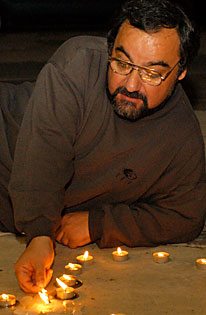 |
|
CHRIS CODUTO/Arizona Daily Wildcat
|
Moji Agha, founder of the Universal Coalition for Interfaith and Intercultural Knowledge and Action, lights a candle Sunday night during an around-the-clock vigil for peace at the Islamic Center of Tucson on East Second Street. The vigil started Friday, and is running until the end of the war with Iraq.
|
|
By Aaron Mackey
Arizona Daily Wildcat
Tuesday March 25, 2003
When the United States government heightened its terrorist threat level last week, the University of Arizona was ready for the higher level, as procedures had already been put in place to deal with any campus emergency.
The Campus Emergency Response Team is responsible for dealing with most campus emergencies and establishing procedures and protocol for the university to follow during an emergency.
However, since Sept. 11 and the College of Nursing shootings, CERT has increased its planning and has redefined how UA would handle emergencies where student lives could be in danger.
While no official action has been taken to increase campus security in light of the higher threat level, Facilities and Risk Management Director Steve Holland said there is "a heightened sense of awareness across campus."
"When the nation is in the state of high alert everyone in the university is a little more vigilant than they might normally be," said university spokesperson Sharon Kha.
Meeting weekly, CERT discusses possible scenarios and how different departments would act in response to specific emergencies.
In all of the scenarios discussed by the team, preservation of life is always the main focus of any action taken, Kha said.
The most difficult part of the planning is that any scenario discussed is based solely on speculation, as no one is certain as to what type of emergency may occur on campus.
CERT must also dictate to all campus organizations how they would respond to an emergency, Holland said.
According to Holland, Risk Management, as always, would handle emergencies such as chemical spills and facilities problems, Holland said.
Holland said that while Risk Management hasn't heightened its security in any way, they have been working closely with CERT to ensure that proper procedures take place in the event of an emergency.
Holland, who is a member of CERT, said the main focus for security in the past few months is getting all the campus departments and organizations on the same page.
By taking a closer look at how emergencies are handled, as well as specifically defining different departmental roles, Holland believes UA will be prepared in the event of a crisis.
"When something does happen, obviously (the university is) going to be well prepared," Holland said.
CERT has also enlisted the help of local government agencies such as the Tucson Fire and Police Departments.
While the Tucson Police Department has not been specifically contacted by UAPD regarding increased security concerns, Sgt. Judy Altieri said they are ready to lend a hand in any way they can.
"Should the need arise that they need additional resources we will be there to assist," Altieri said.
However, Altieri added that as a result of increased security TPD has initiated special checks at what she considers "high risk locations."
Some of these checks, she said, may possibly be near the university.
TPD can also offer assistance to UAPD in the event of large demonstrations or protests, as they did on March 6 when four students locked themselves to a handicapped railing in the Administration building.
While the UA administration and local government agencies are preparing for several different types of emergencies, questions about potential crises still exist.
"Its very difficult to prepare for every possible contingency," Holland said.
Some students living on campus believe they are safe from any potential emergency related to the war.
"I'm not concerned," said Lindsay Downs, a pre-business freshman.
More commonly, students expressed comfort in the security provided on campus and UA's efforts to preserve safety.

